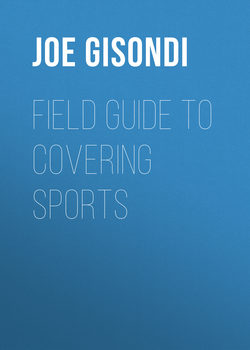Читать книгу Field Guide to Covering Sports - Joe Gisondi - Страница 8
На сайте Литреса книга снята с продажи.
Preface
ОглавлениеI’ll never forget the anxiety I felt writing my first few stories for a daily newspaper—and the kindness shown to me by the sports editors on those late Friday nights. At the time, I was a cocky 17-year-old who had already covered games and written features for two weekly newspapers, and I was sports editor of my high school newspaper—making me a grizzled veteran. Or so I thought.
That first Friday night, I struggled for 15 minutes to craft a lead before an editor told me, “Just write anything. You’ve got about 20 minutes before deadline.” I started to sweat—the warm kind you feel when you’ve forgotten to study for a test or are about to ask someone on a date. The kind that portends failure. I kept plugging away on that electric typewriter, fumbling over notes and writing play-by-play filled with way too many adjectives and far too few details, with quotes that were generic, and a lead that was barely palatable.
Joe Arace, the longtime prep sports editor at The News-Press in Fort Myers, Florida, told me to sit next to him while he edited the story. He deleted adjectives, asked me questions so he could add vivid descriptions, inserted transitions, and moved up key plays and stats. Each keystroke was an execution. Each revision a slap in the face. Each edit proof that I had chosen the wrong career.
Like other kids, I had grown up idolizing sports figures, watching games, reading the sports pages to relive these moments, and dreaming of making it to the big leagues. I hadn’t yet accepted that if I got there, I’d be sitting in the press box. And during my early newsroom nights, even that scenario seemed unlikely.
After Joe sent the story to the copy chief, he turned to me, smiled, and said, “Good job. See you next week.” What? They wanted me to write again? I was shocked. Clearly, I had done something right. But what?
The next morning, my spine tingled when I read the byline: Joe Gisondi. I was a little ashamed that I hadn’t written every word myself. I hadn’t realized yet that journalism is a team game where everyone—assignment editors, copy editors, designers, proofreaders—contributes to a story’s success. That doesn’t mean sports reporters should blithely expect others to correct their mistakes. But it’s nice to know you have that support.
I determined not to repeat the same errors. So I made new ones, which were corrected and revised by editors while I sat and watched, listening to their suggestions and explanations as they worked on my copy. And each week I heard, “Good job. See you next week.”
As I write this book, I hear those editors’ voices, their suggestions, and their encouragement. I hear the voices of the 120-plus sports journalists and coaches who offer advice in these pages on how to cover more than 20 beats, from auto racing to field hockey to wrestling. These voices come not just from The New York Times, Philadelphia Inquirer, ESPN, MLB.com, Yahoo! and Sports Illustrated but also from respected, nontraditional media outlets, such as Bleacher Report, FanGraphs, baseballHQ.com, @RotoGraphs, @Sportsmanias, and from smaller news organizations that employ the majority of sports journalists. In places like Cedar Rapids, Iowa, and Kennebec, Maine, sports coverage means local coverage, and local coverage means kids and schools.
For students and beginning sports journalists, this field guide serves as their portable editor: posing questions, suggesting new approaches, and summarizing the basics needed to cover any game. It offers hands-on, practical advice, the kind given in sports departments across the country. Like the one I sat in so many years ago.
